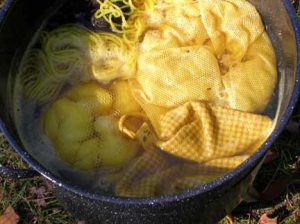Dye Procedure for 4 Ounces of Natural Fibers
NOTE: USE STAINLESS STEEL, ENAMEL, OR GLASS POTS. NEVER USE DYE POTS AND UTENSILS FOR FOOD PREPARATION! MANY DYE INGREDIENTS ARE TOXIC.
PLANT MATERIAL = three to four times the weight of the fiber. Example - a grocery bag full of leaves would not be too much!
PREPARE MATERIALS
chop or grate bark, roots, nut hulls
soak "tough" dye plants overnight
chop stems or leaves
crush or cut up berries and fruits
SIMMER dyestuff in one gallon of water 30 minutes to one hour (use less time for tender plants).
STRAIN - throw out plant material unless recipe suggests you leave it in the dyebath. You might want to put the plant stuff in a net bag, and drop it back in the pot, or you could put your fibers in net bags (old pantyhose work great!). Don't make the mistake of putting plant parts and loose fibers in the pot together - you'll end up with fleece full of seeds, bits of leaves, ground up bark, etc.
ADD WATER to make two or three gallons. Enough water is needed to allow fibers to move freely in the dyepot.
SIMULTANEOUS METHOD OF MORDANTING:
DISSOLVE 1 ½ TEASPOONS of potassium alum in 1 cup of very hot water. If you are anxious to get started but don’t have potassium alum, you can find ammonium alum used for pickling in the grocery store. It works, but not as well, to help the fiber take up and retain color.)
Note: Many of the older dye books recommend using as much as 1 ½ TABLESPOONS of alum for 4 oz. fiber. Some sources recommend the use of cream of tartar as an assistant to help in absorption of alum. For more information, see one of the newer references such as, Wild Color, Jenny Dean, pp. 36 - 45.
ADD alum to dyepot. Stir.
ADD 4 ounces clean, wet, natural fibers.
SIMMER 30 minutes to one hour at 180-190º F. DO NOT BOIL!
COOL in dyepot. Remove fibers and rinse until water is clear. Remember not to change water temperatures radically, which might cause wool to felt.
For cotton and other cellulose fibers different procedures usually are recommended. Still, it is interesting to try some of these dyes on samples of cellulose products to see what happens! Unpredictability is one of the intriguing factors of using dyes from nature.
Dye Books to Look For:
A Weaver's Garden by Rita Buchanan
A Dyer's Garden by Rita Buchanan
Nature's Colors by Ida Grae
Craft of the Dyer by Karen Casselman
Natural Dyes and Home Dyeing by Rita Adrosko
The Art and Craft of Natural Dyeing by J. N. Liles
Wild Color by Jenny Dean
Dye Plants and Dyeing by John and Margaret Cannon

Madder Root on Silk

Natural Dyes on Wool

